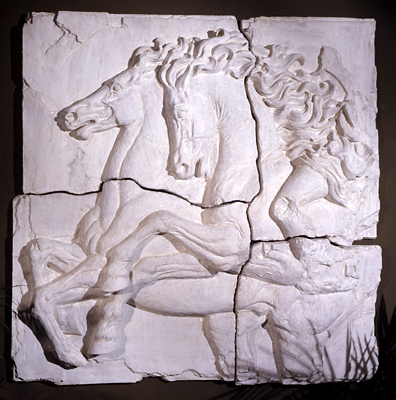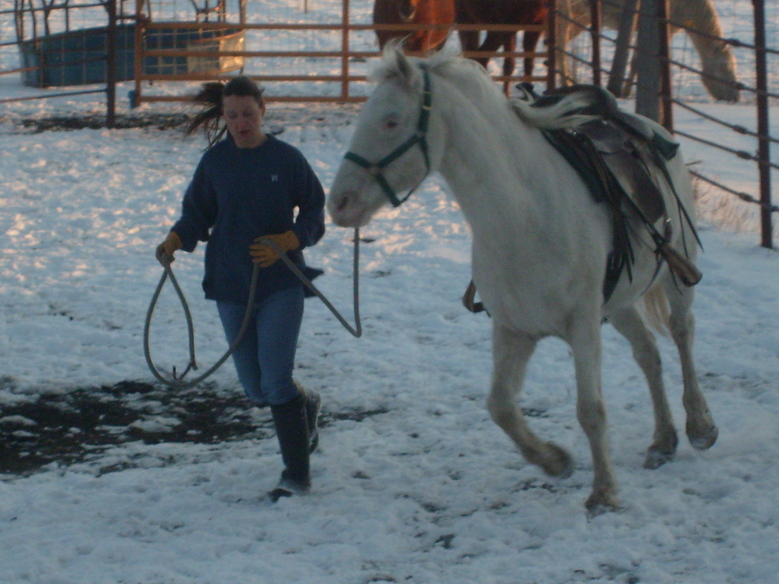
Harmony with Horses
Horses are not the only animals we keep here at Hilltop. I grew up on a cattle ranch, but more recently, it’s our little herd of Nubian goats which consume our time and attention. There are times when I look out into the pasture when horses and goats are scattered throughout, each searching for their favorite weed or grass to munch. Then other times I look, and the herd is moving together, to and from the waterer, or the mineral feeder, and these moments are captivating. They move like a school of fish in the ocean. Evenly spaced, at the same pace, they travel; left, right, sharp left (avoid the dog!) and to their destination, where they halt, drop their heads to eat, and once again become individuals. How do they do that? How do they know when to start, when to turn, when to stop? How do they know when to let their teammate in to play, to join, comfort, protect; and when that mate is there to cause trouble, and needs a warning to back off? How can body language be such an effective means of communication, as to make relationships and understanding possible across species?
Some of the most effective training I have witnessed has very little to do with “training”. There’s a horse, being a horse; athletic, agile, and fast. The human brings to the partnership a plan of action, and communicates it to the horse. With a little skill, the rider will be able to do so in a way his body won’t obstruct or impede the horse’s ability to carry out said plan. The mind of the human, the body of the horse, united in harmony, functioning as a single creature. That kind of unity doesn’t begin in the saddle. It begins on the ground.
We’ve had many temporary horses at our home, but the Spanish weanlings of 2006 were my favorite. They came in a few trailer loads, and I squealed with delight at each unloading of another batch of “babies”. So many colors, shapes and sizes! Some were curious, some skittish, but most had a very minimal idea of who we were or what I we wanted of them. We would go out to see that they were drinking, give them their grain and hay, and tell them, “Hello, I’m a human. My job is to help you.” Clear intent is the first step towards establishing body language that attracts horses. It can also repel horses, if one’s intent is less helpful and more focused on conquering the horse. The kindness and humbleness conveyed in a helpful approach is not the determination of a predator intent on victory. A greedy hunger to capture a horse is something the horse will detect and avoid at all costs. For these young horses with keen senses, strong genetic dispositions for survival and predator avoidance, and a strong yearning to bond tight to the herd, harmony was as desirable to them as it was to us.
The harmony we establish during halter training and in-hand work is directly transferable to the mounted work. The feel of the lead line on the ground is the same feel we’ll encounter in the rein once mounted. Is it pushy or bargy? Is he dragging us, or, are we dragging him? If these things are occurring, neither of us is seeking nor attending to the harmony of the union. There are specific things we can do to improve this situation.
1) He may be too young to begin schooling. Certainly, we can expect a youngster to lead well, trailer load, stand for the farrier, and tolerate basic grooming. But we need to have patience when we ask our youngsters to do these things. As parents, we evaluate our children, to determine readiness for school—how long does his attention hold, how developed are his social skills, has her motor coordination developed enough to allow the child to do what is asked of her…a horse is no different. Expect a young horse to have a shorter attention span than an older one, and plan plenty of breaks to allow him to rest his mind. Do not expect greater performance than his body or mind is able to provide at his age. Forcing a youngster to school before he is ready will spoil his desire to engage in the learning process.
2) If he is mature enough to begin schooling, expect his attention to be short, at first, but gradually lengthen in duration and frequency. Increased attention span does come with maturity, but it can also be nurtured with age-appropriate activities that he considers “play”. Engagement with a human, without a performance expectation, is one of the most productive ways to gain and keep the attention of your horse. Intelligent horses can be the most challenging, but also the easiest to engage in mental activities. Give them games and activities that challenge and intrigue, without frustrating them. If you provide well, they will be daily waiting at the gate for you to come out and “play” with them. This desire for engagement goes a long way towards gaining and maintaining their attention.
Some of the most effective training I have witnessed has very little to do with “training”. There’s a horse, being a horse; athletic, agile, and fast. The human brings to the partnership a plan of action, and communicates it to the horse. With a little skill, the rider will be able to do so in a way his body won’t obstruct or impede the horse’s ability to carry out said plan. The mind of the human, the body of the horse, united in harmony, functioning as a single creature. That kind of unity doesn’t begin in the saddle. It begins on the ground.
We’ve had many temporary horses at our home, but the Spanish weanlings of 2006 were my favorite. They came in a few trailer loads, and I squealed with delight at each unloading of another batch of “babies”. So many colors, shapes and sizes! Some were curious, some skittish, but most had a very minimal idea of who we were or what I we wanted of them. We would go out to see that they were drinking, give them their grain and hay, and tell them, “Hello, I’m a human. My job is to help you.” Clear intent is the first step towards establishing body language that attracts horses. It can also repel horses, if one’s intent is less helpful and more focused on conquering the horse. The kindness and humbleness conveyed in a helpful approach is not the determination of a predator intent on victory. A greedy hunger to capture a horse is something the horse will detect and avoid at all costs. For these young horses with keen senses, strong genetic dispositions for survival and predator avoidance, and a strong yearning to bond tight to the herd, harmony was as desirable to them as it was to us.
The harmony we establish during halter training and in-hand work is directly transferable to the mounted work. The feel of the lead line on the ground is the same feel we’ll encounter in the rein once mounted. Is it pushy or bargy? Is he dragging us, or, are we dragging him? If these things are occurring, neither of us is seeking nor attending to the harmony of the union. There are specific things we can do to improve this situation.
1) He may be too young to begin schooling. Certainly, we can expect a youngster to lead well, trailer load, stand for the farrier, and tolerate basic grooming. But we need to have patience when we ask our youngsters to do these things. As parents, we evaluate our children, to determine readiness for school—how long does his attention hold, how developed are his social skills, has her motor coordination developed enough to allow the child to do what is asked of her…a horse is no different. Expect a young horse to have a shorter attention span than an older one, and plan plenty of breaks to allow him to rest his mind. Do not expect greater performance than his body or mind is able to provide at his age. Forcing a youngster to school before he is ready will spoil his desire to engage in the learning process.
2) If he is mature enough to begin schooling, expect his attention to be short, at first, but gradually lengthen in duration and frequency. Increased attention span does come with maturity, but it can also be nurtured with age-appropriate activities that he considers “play”. Engagement with a human, without a performance expectation, is one of the most productive ways to gain and keep the attention of your horse. Intelligent horses can be the most challenging, but also the easiest to engage in mental activities. Give them games and activities that challenge and intrigue, without frustrating them. If you provide well, they will be daily waiting at the gate for you to come out and “play” with them. This desire for engagement goes a long way towards gaining and maintaining their attention.

3) Teach your horse to follow your feel when you lead him in a halter. When you walk, he should walk. When you jog, he should jog, when you stop, he should stop. At first, they like to do this directly behind your back. It takes some patient explanation to encourage them to step to the left or right of you, and walk shoulder to shoulder (and we should practice both left and right sides equally). This can initially be done on a 12 foot lead rope, but gradually, if practiced enough, you can transition to shadowing each other
2.24.12 TME
Return to Educated Equestrian
Return to Educated Equestrian
without the line attached. Walk, jog, even canter, stop, and back. All these things can be done without pulling or yanking.
If the horse is following pace and directional transitions well on the ground, he has a firm foundation for understanding your expectation and intent, throughout the remainder of your relationship: “Come with me here, stop here. Join me wherever I go, pay attention to where I am and what I’m doing, and do your best to contribute to our harmony.” When harmony with your horse is your foremost objective, your body language can relate that idea in your mind. It is a message your horse will be glad to hear, and you will find he will be able to deliver harmonious responses to well-delivered body language.
If the horse is following pace and directional transitions well on the ground, he has a firm foundation for understanding your expectation and intent, throughout the remainder of your relationship: “Come with me here, stop here. Join me wherever I go, pay attention to where I am and what I’m doing, and do your best to contribute to our harmony.” When harmony with your horse is your foremost objective, your body language can relate that idea in your mind. It is a message your horse will be glad to hear, and you will find he will be able to deliver harmonious responses to well-delivered body language.